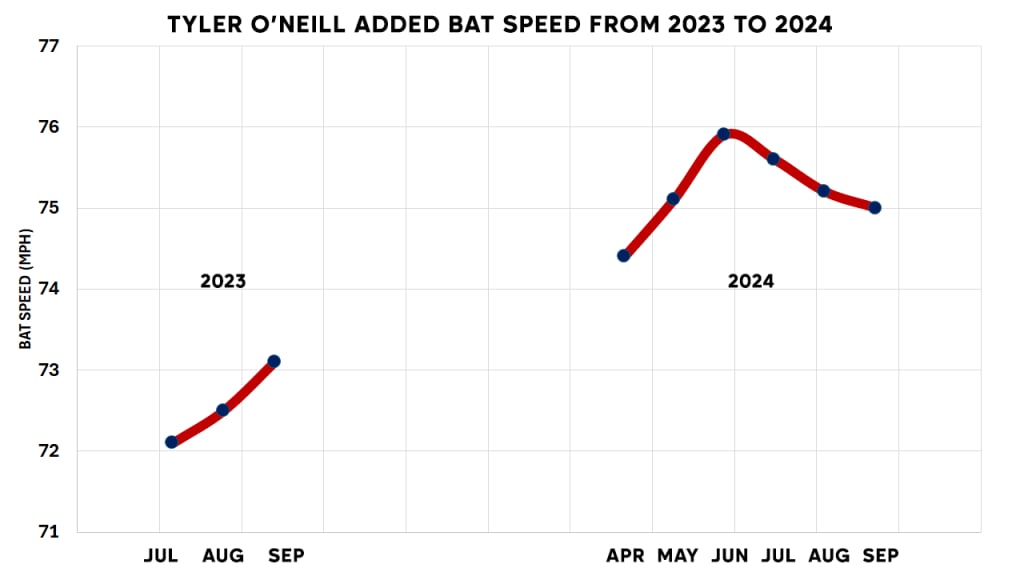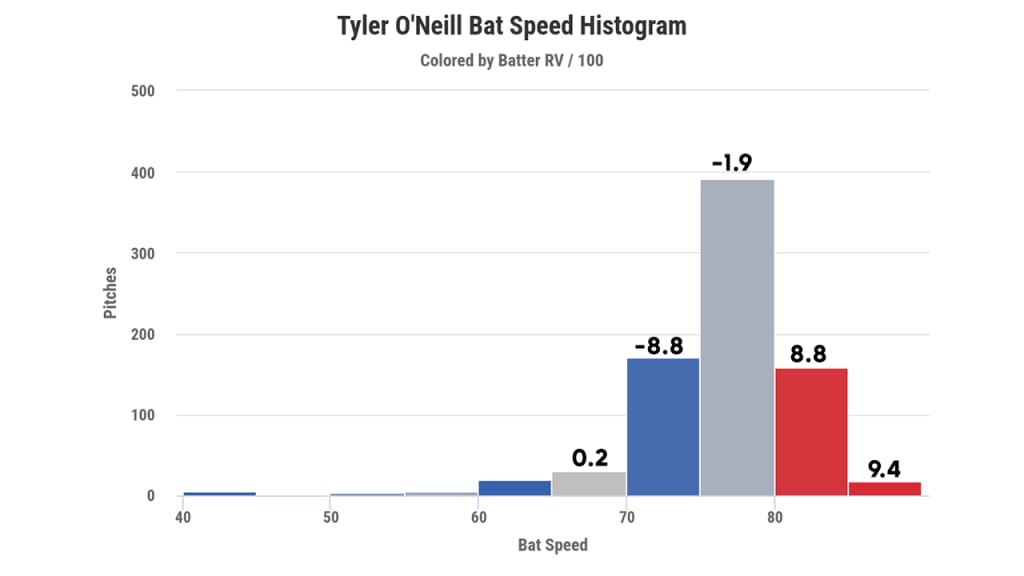In the midst of whatˇŻs otherwise been a surprisingly subdued winter for the Orioles, thereˇŻs at least something interesting to be drawn from Statcast making available 2023 bat tracking data to go along with the previously released 2024 information. Now that thereˇŻs more than one season available ¨C 2023, to be fair, is just post All-Star ¨C the first thing you want to do is see which batters gained or lost the most bat speed between the two seasons.
As youˇŻd expect, this is a skill thatˇŻs relatively stable for most ¨C Giancarlo Stanton, OˇŻNeill Cruz, Kyle Schwarber and friends can be found atop the leaderboard in both seasons. But if we look at players with 100 swings in both seasons, and see who added the most bat speed from the first year to the second, we see two different Baltimore outfielders on the list ¨C one who had a breakout rookie season, and one who was signed to a three-year contract this winter.
Most bat speed gained, 2023-24
- +3.1 mph: Yuli Gurriel
- +3.0 mph: Colton Cowser ˇű 2025 Oriole
- +2.6 mph: Tyler OˇŻNeill ˇű 2025 Oriole
- +2.6 mph: Curtis Mead
- +2.5: mph Paul DeJong
Min. 100 swings in both seasons. 2023 data is second-half only.
ThatˇŻs not a list of baseballˇŻs best hitters, and itˇŻs not supposed to be; after all, how much more bat speed could you really be expecting Aaron Judge and Shohei Ohtani to add? But in the same way that a pitcher adding a few ticks to his fastball is interesting ¨C even if it doesnˇŻt guarantee success ¨C so is this.
After all, thereˇŻs a clear relationship between bat speed and success ¨C just look at the massive difference in production between fast swings and those below the line. ItˇŻs also pretty hard to ignore comments like the ones Red Sox prospect Kristian Campbell, No. 7 on MLB Pipeline's Top 100, gave to FanGraphs, after he skyrocketed from a decent prospect to an elite one over the course of one season, thanks largely to BostonˇŻs program to help him swing faster and get the ball off the ground.
ˇ°Instead of being flat, or straight down, IˇŻm trying to hit the ball at a good angle,ˇ± said Campbell. Red Sox hitting coordinator John Soteropulos added more detail, saying that ˇ°his development program focused on two key objectives, improving ball flight and increasing bat speed.ˇ±
ItˇŻs an incredibly valuable tool to have. It requires context, too. In GurrielˇŻs case, a 40-year-old didnˇŻt magically get stronger so much as he seemed to just be swinging out of his shoes, because while his bat speed and hard-hit rate (from 35% to 54%) both rose, so did his strikeout rate (from 13% to 23%), and ultimately he was just a different shape of ineffective for Kansas City as heˇŻd been for Miami before.
In DeJongˇŻs case, it was a nice rebound season after a few down years. For Mead, itˇŻs hard to draw any real conclusions about a 24-year-old with 224 total Major League plate appearances. But what about the two now-Orioles? ItˇŻs a skill the team values: 2024ˇŻs fourth-best run scoring offense also was tied for baseballˇŻs highest average bat speed. LetˇŻs find out.
Tyler O'Neill
This one might just be an easy story to tell, because itˇŻs seemingly one of health. In 2023, OˇŻNeillˇŻs final year with St. Louis, he played in only 72 underwhelming games, missing two months with a back injury. Signed to a one-year deal with Boston for 2024, he spent the winter working back into shape, as he told the ˇ°Baseball IsnˇŻt Boringˇ± podcast in December 2023.
ˇ°IˇŻve made a lot of adaptations to my training program. IˇŻm working with my new trainers this year,ˇ± OˇŻNeill said. ˇ°It involves a lot more intensive warmups, getting my body ready the right way, more shoulder mobility, more hip mobility. IˇŻm on a core program that I do religiously that helps out my back a lot.ˇ±
It didnˇŻt fully keep him healthy ¨C OˇŻNeill missed time with a concussion and leg injuries ¨C but the bat speed increase was real for the entire season; in July, he was swinging a full 3.5 mph faster than he had been the previous July. The math goes that every extra mile per hour on a hard-hit ball in the air can lead to a gain of around six feet of distance, and wouldnˇŻt you know it ¨C OˇŻNeillˇŻs hard-hit fly balls in July 2024 went 29 feet further, on average, than they did in July 2023.

The potential downside here is that he did strike out a lot more, whiffing 34% of the time after doing so only 25% of the time in 2023. ThereˇŻs definitely a point where the extra strikeouts become too much. But as difficult as it may be to hear for a lot of fans, the striking-out-more, swinging-harder-more version of OˇŻNeill was simply a better hitter. ItˇŻs hard to argue that youˇŻd rather the 2023 version that made more contact with a 94 OPS+ than the 2024 one that whiffed more but posted a 132 OPS+.
If that sounds contradictory, remember that in 2021, his career season when he hit 34 homers and gained down-ballot NL MVP Award support, OˇŻNeill also struck out more than 30% of the time. He actually was less productive as he made more contact in 2022 and ˇŻ23. In other words, maybe donˇŻt worry about the whiffs so much. (ThereˇŻs evidence, too, that Boston had him move up closer in the box, a full five inches farther up than heˇŻd been with St. Louis in 2023.)
But ultimately, the key question is: ˇ°Does it matter?ˇ± And, well, it almost always does. If we split the difference between OˇŻNeillˇŻs two seasons and look at his performance on swings above and below 74 mph, well, see if you can tell the difference here. (This is 2024 only.)
- 74 mph & up // +6 Run Value, .422 wOBA, 60% hard-hit rate
- 73 mph & under // -20 Run Value, .156 wOBA, 27% hard-hit rate
Remember that these are swings only, and OˇŻNeill earned 22 runs back on takes, but the differences here are stark enough that he might be best off not even swinging if he canˇŻt get to that line of fast swings.
Or, for the visual learners: Even though only some of OˇŻNeillˇŻs swings were very hard, they had the best outcomes when he used them.

While it will always be about health with him, heˇŻs also still only entering his age-30 season, which still gives him a little time before the bat speed aging declines start to set in.
Colton Cowser
Cowser, the fifth overall pick in the 2021 Draft, had a pretty wretched introduction to the Majors in 2023, hitting just .115/.286/.148, but it was easy to write it off given that it came in just 77 scattered plate appearances. Coming back in 2024, he claimed a starting job in BaltimoreˇŻs outfield and finished second in the AL Rookie of the Year voting, putting up a 123 OPS+ to go with excellent defense. It's not hard to see that bat moving faster:

The jump in bat speed might have been just about confidence ¨C about being comfortable swinging at the right pitches after a rough introduction to the Majors. On the other hand, he told the Baltimore Banner in December that it was about more than just that, too.
ˇ°This past offseason,ˇ± he told Andy Kostka, meaning prior to 2024, ˇ°it was like, 'OK, how can we be more consistent in our load and in our lower body, in our swing where there wasnˇŻt as many moving parts or as much as a hip slide, so things were in inconsistent spots?' I think that the bat speed increased because I was just in more of a consistent launch position.ˇ±
Proper mechanics lead to better outcomes, or what every pitcher has talked about for 150 years leading to fastball velocity.
The more interesting thing, though, is the dip and rebound in-season in 2024. Around the middle of the year, Cowser started using a slightly heavier bat, telling MLB.com that it was ˇ°a little bit heavier, so maybe slowing me down through the zone a little bit.ˇ± That might seem bad, except it was accompanied by harder contact, with OˇŻs hitting coach Ryan Fuller saying that ˇ°thereˇŻs always trade-offs with the choices you make ˇ if you are using a bigger bat and maintaining bat speed, you have the opportunity to hit it further.ˇ±
Fair enough ¨C though itˇŻs interesting to note that by the end of the season, the speed had ticked back up. As with OˇŻNeill, the value difference for Cowser with bat speed is massive.
- 74 mph & up // -2 Run Value, .396 wOBA, 58% hard-hit rate
- 73 mph & under // -20 Run Value, .223 wOBA, 30% hard-hit rate
And similar to OˇŻNeill, Cowser earned 21 runs back on takes; we always forget how valuable it is not to swing at the bad pitches.
